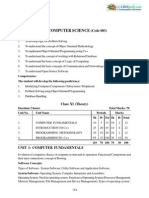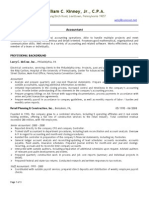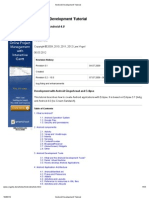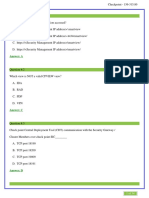0 ratings0% found this document useful (0 votes)
6 viewsC++_Programming_Guide
Uploaded by
raedalkudaryCopyright
© © All Rights Reserved
Available Formats
Download as DOCX, PDF, TXT or read online on Scribd
0 ratings0% found this document useful (0 votes)
6 viewsC++_Programming_Guide
Uploaded by
raedalkudaryCopyright
© © All Rights Reserved
Available Formats
Download as DOCX, PDF, TXT or read online on Scribd
You are on page 1/ 3
Comprehensive Guide to Learning C++
Criteria for Learning C++
Understand the basics of programming: Familiarize yourself with concepts such as
variables, data types, loops, and conditional statements.
Learn the syntax of C++: Study how to write and structure code in C++, including
operators, functions, and control structures.
Master object-oriented programming (OOP): Understand key principles like classes,
objects, inheritance, polymorphism, encapsulation, and abstraction.
Develop problem-solving skills: Practice solving coding challenges to strengthen logical
thinking and algorithm design.
Grasp memory management: Learn how pointers, dynamic memory allocation, and
references work in C++.
Study the C++ Standard Library (STL): Familiarize yourself with STL components such
as vectors, lists, stacks, queues, maps, and algorithms.
Important Libraries in C++
iostream: For input and output operations.
string: To handle and manipulate strings.
vector: To use dynamic arrays.
algorithm: For common algorithms like sorting and searching.
map and set: For associative containers.
fstream: For file input and output operations.
cmath: For mathematical functions like power, square root, and trigonometric
calculations.
thread: For multithreading and concurrent programming.
regex: For regular expressions and pattern matching.
chrono: For handling time and durations.
Roadmap to Learning C++
Step 1: Learn the Basics
- Study the syntax of C++ and write simple programs.
- Understand basic data types, operators, and control structures.
- Practice writing programs that use loops and conditionals.
Step 2: Dive into Object-Oriented Programming (OOP)
- Learn about classes and objects.
- Implement inheritance, polymorphism, and encapsulation in projects.
- Create programs that utilize OOP principles effectively.
Step 3: Explore Advanced Topics
- Understand memory management and pointers.
- Practice working with dynamic memory allocation and references.
- Learn about file handling using fstream.
Step 4: Master the Standard Template Library (STL)
- Study and practice using STL containers like vector, list, and map.
- Learn how to use STL algorithms for operations like sorting and searching.
Step 5: Build Projects
- Start with simple projects such as a calculator, to-do list, or number guessing game.
- Progress to complex projects like a library management system or game development
using SFML (Simple and Fast Multimedia Library).
Step 6: Learn Debugging and Optimization
- Use tools like GDB (GNU Debugger) for debugging.
- Learn techniques to optimize code for performance.
Step 7: Explore Advanced Libraries and Topics
- Study multithreading and concurrency using the thread library.
- Learn about regular expressions with the regex library.
- Explore graphical programming using libraries like Qt or SDL.
Examples of Simple Programs
Hello World Program:
```cpp
#include <iostream>
using namespace std;
int main() {
cout << "Hello, World!" << endl;
return 0;
}
```
Program to Calculate Factorial:
```cpp
#include <iostream>
using namespace std;
int factorial(int n) {
return (n <= 1) ? 1 : n * factorial(n - 1);
}
int main() {
int num;
cout << "Enter a number: ";
cin >> num;
cout << "Factorial of " << num << " is " << factorial(num) << endl;
return 0;
}
```
Using Vectors to Store Data:
```cpp
#include <iostream>
#include <vector>
using namespace std;
int main() {
vector<int> numbers = {1, 2, 3, 4, 5};
cout << "Numbers in the vector: ";
for (int num : numbers) {
cout << num << " ";
}
cout << endl;
return 0;
}
```
You might also like
- Guidelines For CSB Candidates PGT ComputNo ratings yetGuidelines For CSB Candidates PGT Comput11 pages
- Get Test bank for Data Structures and Algorithms in C++ 2nd Edition by Goodrich free all chapters100% (17)Get Test bank for Data Structures and Algorithms in C++ 2nd Edition by Goodrich free all chapters49 pages
- Test bank for Data Structures and Algorithms in C++ 2nd Edition by Goodrich pdf download100% (1)Test bank for Data Structures and Algorithms in C++ 2nd Edition by Goodrich pdf download39 pages
- Test bank for Data Structures and Algorithms in C++ 2nd Edition by Goodrich 2024 scribd download full chapters100% (16)Test bank for Data Structures and Algorithms in C++ 2nd Edition by Goodrich 2024 scribd download full chapters40 pages
- Course Outline Introduction to ProgrammingNo ratings yetCourse Outline Introduction to Programming2 pages
- PG - MCA - Computer Applications - 315 14 - Data Structure Using C++ Lab - MCANo ratings yetPG - MCA - Computer Applications - 315 14 - Data Structure Using C++ Lab - MCA104 pages
- Class: XI Subject: Computer Science Max Marks: 70No ratings yetClass: XI Subject: Computer Science Max Marks: 704 pages
- Banerjee P. From Novice To Ninja. Mastering DSA in C++ 2023No ratings yetBanerjee P. From Novice To Ninja. Mastering DSA in C++ 2023104 pages
- Gujarat Board Computer Science Class 12-SyllabusNo ratings yetGujarat Board Computer Science Class 12-Syllabus2 pages
- Computer Programming CP Course Plan SpringNo ratings yetComputer Programming CP Course Plan Spring6 pages
- Course Outline Prog Fundamental Session2014No ratings yetCourse Outline Prog Fundamental Session20143 pages
- Mastering Python: A Comprehensive Guide for Beginners and ExpertsFrom EverandMastering Python: A Comprehensive Guide for Beginners and ExpertsNo ratings yet
- Protecting Efuses and JTAG From Updates (R6T3, U6T1, U6T2 Methods)No ratings yetProtecting Efuses and JTAG From Updates (R6T3, U6T1, U6T2 Methods)8 pages
- Compiler Design 6TH SEM CST CSE CSE AIME IT M440No ratings yetCompiler Design 6TH SEM CST CSE CSE AIME IT M4402 pages
- Replacing A Failed or Removed Disk Via Vxdiskadm (Option 5) May Fail With "Test: Argument Expected".No ratings yetReplacing A Failed or Removed Disk Via Vxdiskadm (Option 5) May Fail With "Test: Argument Expected".3 pages
- Software Testing: ©ian Sommerville 2004No ratings yetSoftware Testing: ©ian Sommerville 200455 pages
- BOLT! Mobile WiFi MF90 Update Tool v1.1 Manual Instruction For WindowsNo ratings yetBOLT! Mobile WiFi MF90 Update Tool v1.1 Manual Instruction For Windows7 pages
- Steganography - Technique To Hide Information Within Image FileNo ratings yetSteganography - Technique To Hide Information Within Image File4 pages
























































































